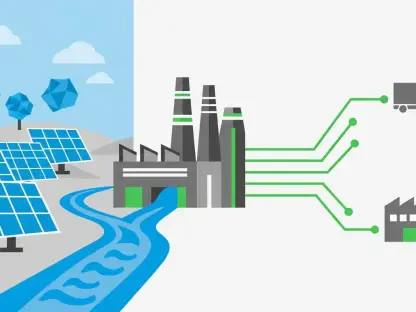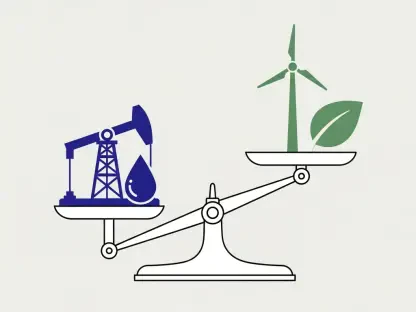As the world grapples with an ever-increasing demand for electricity, projected by the International Energy Agency to account for over 50 percent of global energy consumption in the next 25 years, the urgency for sustainable solutions has reached a critical peak, and solar power stands as a beacon of hope in this landscape. Yet, current technologies often fall short in efficiency and scalability. A groundbreaking development in material science, driven by artificial intelligence (AI), now promises to change the game. Researchers have turned their focus to halide perovskites, a class of materials with extraordinary potential to revolutionize solar cells through affordability and adaptability. This article explores how AI is unraveling the mysteries of these next-generation materials, particularly formamidinium lead iodide, offering a glimpse into a future where clean, renewable energy could power everyday life with unprecedented efficiency.
Revolutionizing Solar Tech with Halide Perovskites
Halide perovskites have emerged as a transformative force in the realm of solar energy, captivating researchers with their unique blend of cost-effectiveness and versatility. These materials, especially formamidinium lead iodide, boast exceptional light absorption and emission properties, making them ideal candidates for creating solar cells that are not only efficient but also remarkably flexible. Imagine a world where smartphones, vehicles, and even building facades are coated with thin, lightweight solar films that harness energy seamlessly. Such applications are within reach due to the inherent qualities of these compounds. However, a significant barrier has persisted—instability. This flaw has prevented widespread adoption, as the materials often degrade over time, rendering them impractical for long-term use. Understanding their structural intricacies has thus become a priority for scientists aiming to unlock their full potential in real-world scenarios.
Beyond their physical attributes, halide perovskites represent a shift toward more accessible renewable energy solutions. Their affordability compared to traditional silicon-based solar cells could democratize access to clean power, particularly in regions where cost has been a prohibitive factor. The challenge lies in decoding the complex behaviors of these materials under varying conditions, such as temperature fluctuations, which impact their performance. Formamidinium lead iodide, while promising, has puzzled experts with its unpredictable structural shifts, especially at lower temperatures. Addressing this gap in knowledge is essential to engineering solutions that maintain efficacy over extended periods. The journey to overcome these hurdles has led researchers to explore innovative tools, setting the stage for a technological leap that could redefine the solar industry’s future.
AI as a Game-Changer in Material Analysis
At the forefront of this scientific endeavor, a team from Chalmers University of Technology in Sweden has harnessed the power of AI to dissect the enigmatic properties of formamidinium lead iodide. Under the leadership of Associate Professor Julia Wiktor, the researchers have developed simulation models that dwarf previous efforts in both scale and detail. These simulations, incorporating millions of atoms, replicate real-world conditions with astounding accuracy, running thousands of times longer than earlier models. This leap in computational capability has finally unveiled the elusive low-temperature phase of the material—a structural mystery that traditional experimental methods struggled to resolve. The insights gained from this AI-driven approach mark a turning point, offering a clearer understanding of how to manipulate and stabilize these promising compounds for practical use.
The significance of AI in this context extends beyond mere data processing; it represents a paradigm shift in how material science tackles complex challenges. By simulating interactions at an unprecedented scale, the technology allows researchers to observe behaviors that were previously hidden, providing a virtual laboratory where hypotheses can be tested without the constraints of physical experiments. This method not only saves time but also reduces costs associated with iterative testing. For formamidinium lead iodide, the detailed mapping of its low-temperature structure has opened doors to predicting how it might react when combined with other substances. Such predictive power is invaluable, as it guides the development of more robust solar cell materials. The success of this approach at Chalmers University highlights AI’s potential to accelerate discoveries across the broader field of renewable energy research.
Merging Computational Insights with Experimental Validation
The integration of AI-driven simulations with real-world experimentation underscores the importance of a balanced scientific approach in advancing solar technology. In collaboration with the University of Birmingham, the Chalmers team validated their computational findings by subjecting formamidinium lead iodide to extreme conditions, cooling it to -200°C to mirror the simulated environment. This rigorous testing confirmed the accuracy of the AI models, demonstrating that the identified low-temperature phase was not merely theoretical but observable in practice. Such synergy between digital and physical research methods ensures that the results are not only innovative but also reliable, laying a solid foundation for future applications. This partnership exemplifies how interdisciplinary efforts can bridge gaps between theory and reality, fostering confidence in the potential of halide perovskites.
Moreover, this collaborative effort reveals the broader implications of combining cutting-edge technology with traditional scientific rigor. Experimental validation serves as a critical checkpoint, ensuring that AI-generated insights align with tangible outcomes. The ability to replicate simulation conditions in a controlled setting at the University of Birmingham provided essential feedback, refining the models further. This iterative process is vital for translating research into actionable solutions, particularly in the context of solar energy where material durability is paramount. The successful confirmation of the structural properties of formamidinium lead iodide under extreme cold offers a blueprint for testing other materials in the halide perovskite family. As such, this dual approach sets a precedent for how complex scientific inquiries can be tackled efficiently, paving the way for accelerated progress in renewable energy innovation.
Tackling the Instability Barrier
One of the most persistent obstacles in utilizing formamidinium lead iodide for solar cells has been its tendency to degrade, undermining its viability for long-term deployment. The recent AI-driven revelations about its low-temperature structure provide a crucial stepping stone toward overcoming this challenge. With a detailed map of how the material behaves under specific conditions, scientists can now explore strategies to enhance its stability. One promising avenue involves blending different types of halide perovskites to create hybrid compositions that counteract degradation. This mixing approach, informed by precise structural data, could result in solar cells that withstand environmental stresses far better than current iterations, making them suitable for widespread commercial use.
The focus on stability is not just about extending the lifespan of solar cells but also about ensuring consistent performance across diverse climates and applications. The newfound understanding of formamidinium lead iodide’s behavior allows for tailored modifications that address specific weaknesses, such as sensitivity to moisture or temperature changes. By leveraging AI simulations to predict outcomes of various material combinations, researchers can minimize trial-and-error in the lab, honing in on formulations that offer the best balance of efficiency and resilience. This targeted methodology represents a significant departure from past efforts, which often relied on less precise experimentation. As stability concerns are mitigated, the path clears for integrating these advanced materials into everyday technologies, from portable devices to large-scale energy grids, amplifying their impact on global sustainability goals.
Envisioning a Renewable Energy Horizon
Looking ahead, the methodologies pioneered by the Chalmers team hold transformative potential not just for formamidinium lead iodide but for the entire spectrum of halide perovskites. The fusion of machine learning with high-performance computing establishes a new benchmark for material discovery, enabling researchers to analyze complex compounds with unprecedented speed and accuracy. This approach could drastically shorten the timeline for developing next-generation solar power materials, bringing efficient and adaptable solutions to market sooner. The ripple effects of such advancements may extend to other renewable energy sectors, where similar computational techniques could unlock innovations in battery storage or wind energy components, further bolstering the shift toward a cleaner planet.
The broader impact of this research lies in its capacity to inspire a wave of technological progress that prioritizes sustainability. As AI continues to refine the study of materials like halide perovskites, the dream of solar cells integrated into everyday objects—think flexible panels on clothing or transparent films on windows—moves closer to reality. Beyond immediate applications, the data-driven strategies developed here offer a scalable framework for tackling other scientific challenges in energy conversion. The groundwork laid by these findings encourages continued investment in computational tools and interdisciplinary partnerships, ensuring that the pace of innovation keeps up with global energy demands. Ultimately, this work signals a future where renewable sources dominate, powered by materials once thought too unstable to harness effectively.









